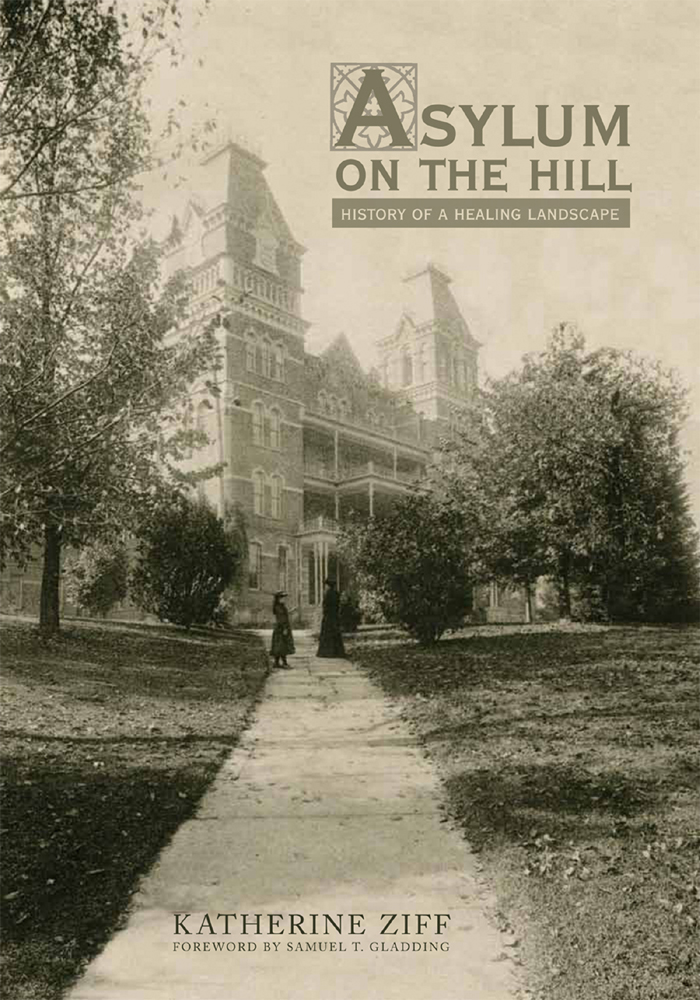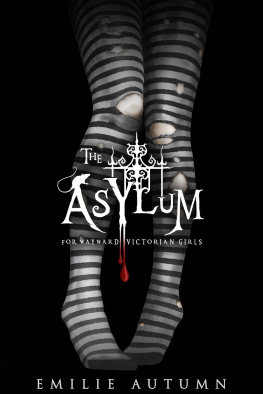Ziff Katherine - Asylum on the hill history of a healing landscape
Here you can read online Ziff Katherine - Asylum on the hill history of a healing landscape full text of the book (entire story) in english for free. Download pdf and epub, get meaning, cover and reviews about this ebook. City: Athens;OH, year: 2012, publisher: Ohio University Press, genre: Home and family. Description of the work, (preface) as well as reviews are available. Best literature library LitArk.com created for fans of good reading and offers a wide selection of genres:
Romance novel
Science fiction
Adventure
Detective
Science
History
Home and family
Prose
Art
Politics
Computer
Non-fiction
Religion
Business
Children
Humor
Choose a favorite category and find really read worthwhile books. Enjoy immersion in the world of imagination, feel the emotions of the characters or learn something new for yourself, make an fascinating discovery.

- Book:Asylum on the hill history of a healing landscape
- Author:
- Publisher:Ohio University Press
- Genre:
- Year:2012
- City:Athens;OH
- Rating:4 / 5
- Favourites:Add to favourites
- Your mark:
- 80
- 1
- 2
- 3
- 4
- 5
Asylum on the hill history of a healing landscape: summary, description and annotation
We offer to read an annotation, description, summary or preface (depends on what the author of the book "Asylum on the hill history of a healing landscape" wrote himself). If you haven't found the necessary information about the book — write in the comments, we will try to find it.
Asylum on the hill history of a healing landscape — read online for free the complete book (whole text) full work
Below is the text of the book, divided by pages. System saving the place of the last page read, allows you to conveniently read the book "Asylum on the hill history of a healing landscape" online for free, without having to search again every time where you left off. Put a bookmark, and you can go to the page where you finished reading at any time.
Font size:
Interval:
Bookmark:

ASYLUM ON THE HILL

Ohio University Press, Athens, Ohio 45701
ohioswallow.com
2012 by Ohio University Press
All rights reserved
To obtain permission to quote, reprint, or otherwise reproduce or distribute material from Ohio University Press publications, please contact our rights and permissions department at (740) 593-1154 or (740) 593-4536 (fax).
Printed in the United States of America
Ohio University Press books are printed on acid-free paper
20 19 18 17 16 15 14 13 12 5 4 3 2 1
Library of Congress Cataloging-in-Publication Data
Ziff, Katherine K.
Asylum on the hill : history of a healing landscape / Katherine Ziff ; forewordby Samuel T. Gladding.
p. ; cm.
Includes bibliographical references and index.
ISBN 978-0-8214-1973-1 (hc : alk. paper)
I. Title.
[DNLM: 1. Athens Lunatic Asylum (Athens, Ohio) 2. Hospitals, Psychiatrichistory Ohio. 3. Empathy Ohio. 4. History, 19th Century Ohio. 5. MentalDisorders therapy Ohio. 6. Professional-Patient Relations Ohio. 7. Psychiatryhistory Ohio.
WM 28 AO3]
362.2109771 dc23
2011041136
![]()
The Moral Treatment Experiment
A Magnificent Site Overlooking the Hocking Valley
Patients
Each Admission Represented a Poor, Helpless, Hopeless Sufferer
Architecture
Space, Light and Air to Each Patient
Politics
Partisan Interests and Personal Place-Seeking
Landscape
Of Beautiful and Varied Scenery
Caregivers
To Take Proper Care of the Insane Requires Talents of a High Order
![]()
Some books are a joy to read. They are filled with information that is fascinating and informative. They entice you with their style, and before you know it you are into the text wholeheartedly and passionately. There is no logical explanation except that you are intrigued with what comes next and your expectations will not allow you to do anything else but read on. Katherine Ziffs Asylum on the Hill: History of a Healing Landscape is such a work. It covers a fascinating period in the history of American psychiatry that is now vanished but left an indelible mark for the positive and progressive impact it had on mental health care.
Dr. Ziffs focus on the Athens asylum is specific to the treatment of the mentally disturbed in Ohio in the late 1800s and captures a moment in time. It follows the ascendance of moral therapy as a movement that was humane and effective with those who were mentally distraught or thought to be such by their families and society. Ziff chronicles the lives of individuals who were admitted and treated, at least initially, from the moral therapy perspective. She humanizes notes made in the margins of official records of often-marginalized people who were in many ways similar to those with mental disorders today. Through a fascinating series of photographs, Dr. Ziff shows us what moral treatment was like in both the planning and the implementation of this unique way of helping the desperate, depressed, downtrodden, demented, anxious, and discouraged. She brings the reader into the sights, sounds, and even smells of postCivil War America in Ohio. She describes, using the original records, the ways treatment for the insane worked and did not workat least in this rural community in the Midwest.
Dr. Ziff gives us an insiders look at an asylum that dwarfed other buildings in its surroundings and, though carefully constructed, was not always lovingly cared for. She depicts the peoplethe patients and their familieswho occupied the halls and challenged the minds of the times as individuals much like many Americans today. She traces the rationale for the moral therapy movement, its successes, and why it faded in its effectiveness and funding. She explains the reasons the movement, like those it touched, had a life but then failed to survive, let alone thrive. Her portraits of people who influenced the asylum are wonderfully rendered in words and pictures. This historical examination of the Hocking Valley, its people, and the asylum that impacted them is alive and moving. The extensive information within the pages of this text makes what was existentially enchanting relevant to our time.
Thus, when reading this book, a person is drawn past olden times and into scenes that have a universal dimension to them. The history of the past becomes a present reality; the people described become our neighborsonly from an earlier era. We can see ourselves and those we know in these individuals and in the treatment they received. Likewise, we know the caregivers, politicians, and landscapes within this story, for though shaped in the late 1800s, they are the forebearers and even the standard-bearers of the society that has since evolved and in which we live.
Anyone who peruses Ziffs work will not have an easy time putting it down. This book is more than a history of a time, a place, a movement, and a people. It is instead a sensitive and centered examination of growth and regression in the understanding of humankind amid stress, development, and regression. It is an exceptional peek into what life is and can be, along with what life has been. It is about a time and a movement that will always be timeless and moving in their emphasis on health, wholeness, and helping. Through Katherine Ziff, Athens, Ohio, and moral therapy come to life and become inescapably intertwined with our lives!
Samuel T. Gladding, PhD
Chair and Professor, Department of Counseling
Wake Forest University
![]()
In 1867 the Ohio legislature laid the foundation for a twenty-year experiment in moral treatment psychiatry at Athens, a small village in the rural southeastern corner of the state. Built to American psychiatrys nineteenth-century gold standard, the Kirkbride plan for moral treatment, the Athens Lunatic Asylum proposed to cure its patients with orderly routines, beautiful views of the countryside, exposure to the arts, a built environment with abundant natural light and plenty of ventilation, outdoor exercise, useful occupation, and personal attention from a physician. Its restorative landscape and efforts to offer humane treatment were a revolution in care for those with mental illness and stand in contrast to hundreds of years of treatment featuring confinement, restraint, and punishment. Nearly a century and a half later, the asylum is making new history as one of the most fully realized examples of the repurposing of old Kirkbride buildings into a university and community resource.
I moved to Athens, Ohio, in 1998. On the first day of my first visit to town, I walked with my son over to The Ridges, the new name for the complex of buildings and landscape that were once the Athens Lunatic Asylum. As we climbed the steep hill to watch bicycle racers rattle over the brick drive around the old asylum buildings, my first impression was of trees. To reach the imposing brick buildings, we walked through a small grove of towering evergreens, remnants of the original landscape planted more than a century ago by landscape gardener George Link and the group of asylum patients who served as his work crew. The buildings and their grounds sit on top of a long and substantial terrace flanking the Hocking River, formed two million years ago in a collision of geology and climate change in southeastern Ohio. If you drive down Route 33 from Columbus, Ohio, toward Athens, just after you pass through Lancaster you will see, as we say in southeastern Ohio, where the glacier stopped. There the flat terrain gives way to gentle hills that become steeper as you get to Athens, following Highway 33, which crosses the Hocking River twice. As rivers go, Nearly two millennia later on this site were established the hopes for a healthy, harmonious therapeutic community dedicated to healing persons with mental illness. Ohio University is now the steward of over seven hundred acres of this landscape. Part of the complex originally named the Athens Lunatic Asylum, the land supported the asylums dairy, orchards, park, lakes, greenhouses, kitchen gardens, piggery, and herds of cattle.
Font size:
Interval:
Bookmark:
Similar books «Asylum on the hill history of a healing landscape»
Look at similar books to Asylum on the hill history of a healing landscape. We have selected literature similar in name and meaning in the hope of providing readers with more options to find new, interesting, not yet read works.
Discussion, reviews of the book Asylum on the hill history of a healing landscape and just readers' own opinions. Leave your comments, write what you think about the work, its meaning or the main characters. Specify what exactly you liked and what you didn't like, and why you think so.











